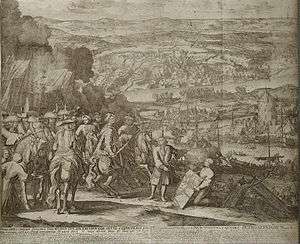Russo-Turkish War (1686–1700)
| Russo-Turkish War (1686–1700) | |||||||
|---|---|---|---|---|---|---|---|
| Part of Great Turkish War | |||||||
 Capture of Azov by Russian emperor Peter the Great (on horseback) | |||||||
| |||||||
| Belligerents | |||||||
|
|
| ||||||
| Commanders and leaders | |||||||
|
|
| ||||||
| Strength | |||||||
|
330,000 (Only Crimean front) Total: Unknown |
14,000 (Only Crimean front) Total: Unknown | ||||||
| Casualties and losses | |||||||
| Unknown | Unknown | ||||||
The Russo–Turkish War of 1686–1700 was part of the joint European effort to confront the Ottoman Empire. The larger European conflict was known as the Great Turkish War.
The Russo–Turkish War began after the Tsardom of Russia joined the European anti-Turkish coalition (Habsburg Austria, Poland–Lithuania, Venice) in 1686, after Poland-Lithuania agreed to recognize Russian incorporation of Kiev and the left-bank of the Ukraine.[2]
War
During the war, the Russian army organized the Crimean campaigns of 1687 and 1689 both which ended in Russian defeats.[3] Despite these setbacks, Russia launched the Azov campaigns in 1695 and 1696, and after raising the siege in 1695[4] successfully occupied Azov in 1696.[5]
Peace treaty
In light of preparations for the war against the Swedish Empire, Russian Tsar Peter the Great signed the Treaty of Karlowitz with the Ottoman Empire in 1699.[6] The subsequent Treaty of Constantinople in 1700, ceded Azov, the Taganrog fortress, Pavlovsk and Mius to Russia and established a Russian ambassador in Constantinople, and secured the return of all prisoners of war.[7] The Tsar also affirmed that his subordinates, the Cossacks, would not attack the Ottomans, while the Sultan affirmed his subordinates, the Crimean Tatars, would not attack the Russians.
References
- ↑ Treaty of Constantinople (1700), Alexander Mikaberidze, Conflict and Conquest in the Islamic World: A Historical Encyclopedia, Vol. 1, ed. Alexander Mikaberidze, (ABC-CLIO, 2011), 250.
- ↑ William C. Fuller, Strategy and Power in Russia 1600-1914, (MacMillan Inc., 1992), 16.
- ↑ Lindsey Hughes, Sophia, Regent of Russia: 1657 - 1704, (Yale University Press, 1990), 206.
- ↑ Brian Davies,Warfare, State and Society on the Black Sea Steppe, 1500–1700, (Routledge, 2007), 185.
- ↑ The Crimean Tatars and the Austro-Ottoman Wars, Dan D.Y. Shapira, The Peace of Passarowitz, 1718, ed. Charles W. Ingrao, Nikola Samardžić, Jovan Pesalj, (Purdue University Press, 2011), 135.
- ↑ Robert Bideleux and Ian Jeffries, A History of Eastern Europe: Crisis and Change, (Routledge, 1998), 86.
- ↑ Treaty of Constantinople (1700), Alexander Mikaberidze, Conflict and Conquest in the Islamic World: A Historical Encyclopedia, Vol. 1, 250.